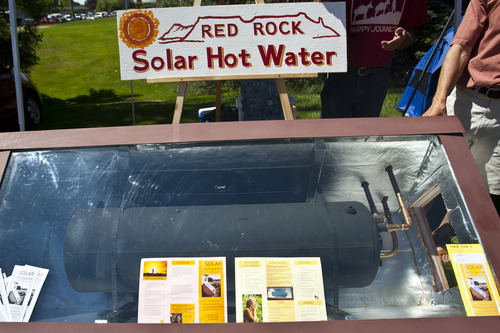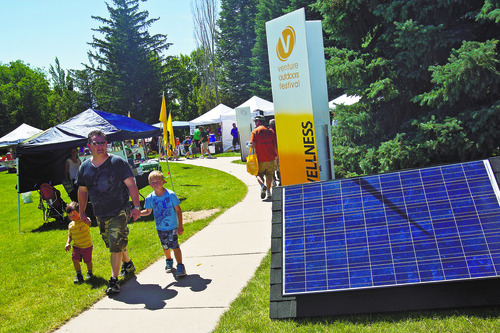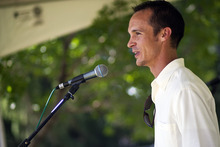This is an archived article that was published on sltrib.com in 2012, and information in the article may be outdated. It is provided only for personal research purposes and may not be reprinted.
Millcreek • Like a lot of people who strolled past the tables and tents at Solar Day Salt Lake on Saturday, Bill Hahnenberger didn't come looking to buy anything.
But he did leave with a brochure for a simple solar heat collector box that could assist his gas-fired water heater and save some money. The company selling them charges $700 for a 40-gallon tank and $1,100 for an 80-gallon tank, and Hahnenberger figured it might make sense, especially because he has a hot tub to fill.
He said he's unsure why more Americans don't use something like this, a "low-tech option that works."
"We were in Turkey last year," he said, "and every house had one of these on the roof to heat their water."
Solar Day Salt Lake, in its second year, is meant to give renewable energy advocates and contractors a chance to elevate sun power's visibility in a state that has plenty of rays but only a few percentage points of its electricity coming from any renewable source.
Most people wandering through Canyon Rim Park appeared to be headed to the much larger Venture Outdoors Festival held at the park at the same time. But Alan Naumann, event coordinator and an employee of photovoltaic panel seller Synergy Power, said the time is right to start paying attention to solar power.
"The lowest price in the industry [history] is now," he said, largely because of increasing competition among equipment makers. Home generation from roof panels now usually costs 10 to 14 cents per kilowatt hour in Utah, compared to coal power that ranges as low as 8 cents, he said.
But people with cash or low-interest financing can get solar for even cheaper than coal power, he said.
Ken Gardner of Gardner Engineering gave an example of a system he installs to power a home of up to 1,800 square feet for $13,350, or $7,345 after tax credits. Over the system's 30-year life, it will generate 133,200 kilowatt hours, bringing the cost per kilowatt hour to less than 6 cents. The sticking point is that up-front cost, he said, but loan programs now enable buyers to put 25 percent down and pay 5.5 percent for three years.
"If we show people [the costs] long-term, they understand it and can buy in," he said.
Rocky Mountain Power uses any excess power that a home on the grid produces and credits the owner toward the next month's bill. Many systems, though, just reduce an owner's monthly bill significantly.
Naumann said Utah could make much better use of its sunshine if the state government would support it. Gov. Gary Herbert's 10-year energy plan talks about renewables, he said, but it doesn't offer anything like a sales-tax holiday for solar panels — something Naumann believes could help make the source more competitive.
In the meantime, while states like California and Colorado mandate certain amounts of renewables in their energy portfolios, he said, Utah continues to effectively subsidize fossil fuels by keeping production taxes lower than in surrounding states.
Through the Utah Sustainable Energy Alliance, contractors in the solar business on Saturday announced a pledge to donate panels to Interfaith Power & Light, a nonprofit group of interdenominational environmentalists seeking to lower the carbon footprints of churches. Naumann was unsure how many contractors would donate — he's seeking one panel from each — but it probably would amount to enough to power one church.
"We're about helping people connect their faith and their ecology," said Susan Soleil, executive director of Interfaith Power & Light. For her, it's about fighting climate change caused by fossil fuels. "We would love it if every house of worship had solar panels. What a great way to say we are taking care of God's creation."
For now, she said, only a few Utah churches, including a couple of Mormon wardhouses, have solar power. Several more are planning to add it, though.
Sunny ideas
For online information about planning and installing solar energy equipment at home, visit http://utahcleanenergy.org/homes/solar









